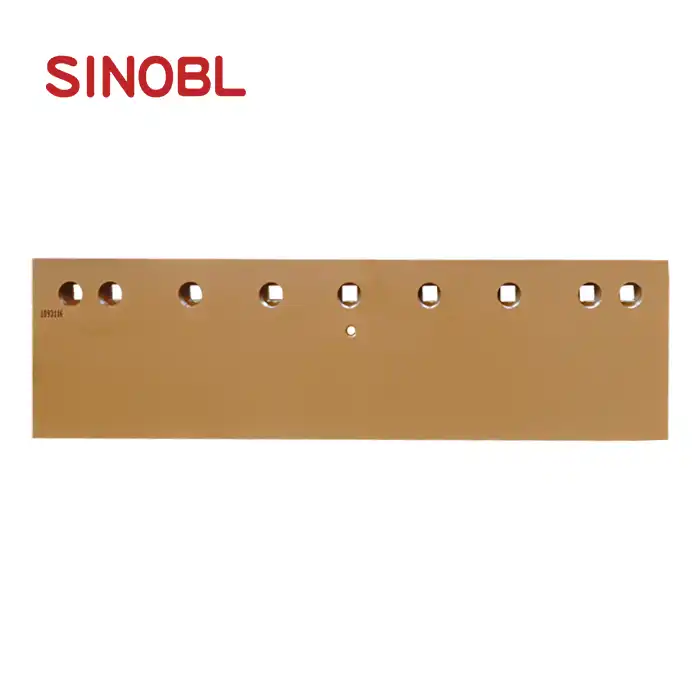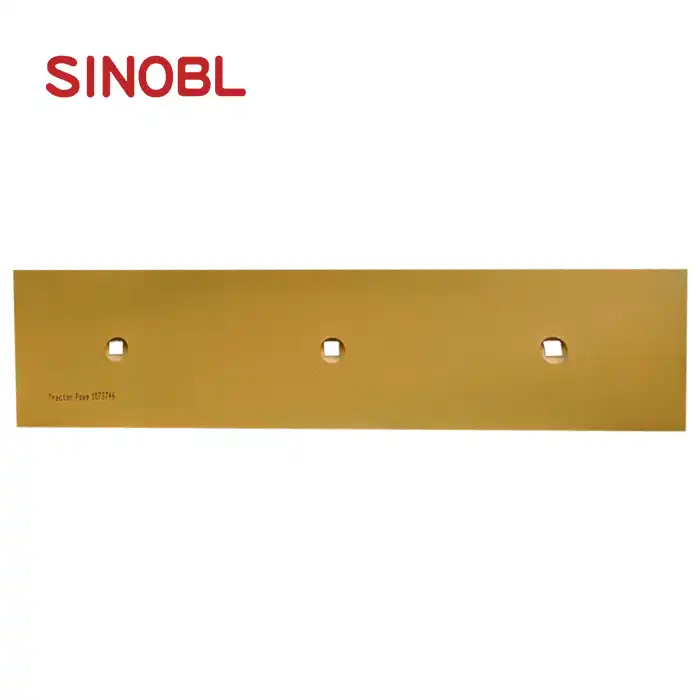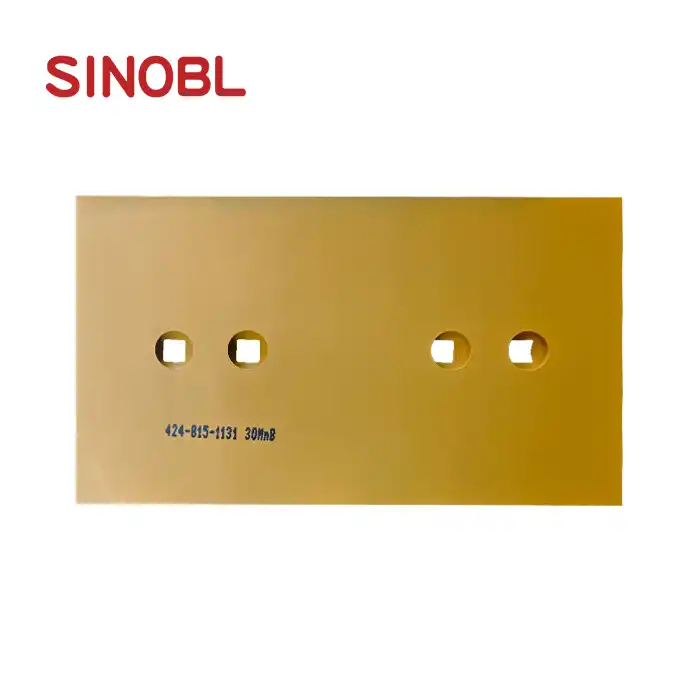How to Properly Install the Grader Overlay 6D1904?
The proper installation of a Grader Overlay 6D1904 is crucial for maximizing equipment performance and operational lifespan. This precision-engineered component, manufactured by Shanghai Sinobl Precision Machinery Co., Ltd., requires careful handling and specific installation procedures to ensure optimal functionality. When correctly installed, the Grader Overlay 6D1904 significantly enhances wear protection for your motor graders, reducing downtime and maintenance costs while improving grading efficiency across road construction, mining, and agricultural applications. This comprehensive guide provides step-by-step instructions for professional installation, ensuring you get the maximum benefit from this premium quality wear part.
Essential Preparation Steps for Grader Overlay 6D1904 Installation
Gathering the Required Tools and Equipment
Before beginning the installation process for your Grader Overlay 6D1904, it's essential to gather all necessary tools and equipment. The Grader Overlay 6D1904, crafted from high-carbon steel and heat-treated boron steel, weighs approximately 9.5KG with dimensions of 12×235×463.2mm, requiring proper handling equipment. Start by assembling a complete toolkit including a torque wrench, which is critical for achieving the manufacturer-recommended bolt tension. Include various socket sizes compatible with the mounting hardware specific to your grader model. Safety equipment is equally important – heavy-duty gloves will protect your hands while handling the sharp edges of the Grader Overlay 6D1904, and safety glasses shield your eyes from potential metal fragments or debris. Additionally, ensure you have proper lifting equipment if working with multiple overlays, as the cumulative weight can be substantial. Having cleaning supplies like wire brushes and solvent is necessary for preparing the mounting surface, ensuring the Grader Overlay 6D1904 sits flush against the blade, maximizing its effectiveness and preventing premature wear or damage during operation.
Inspecting Your New Grader Overlay 6D1904
A thorough inspection of your newly acquired Grader Overlay 6D1904 is a critical preliminary step that should never be overlooked. SINOBL's quality control process includes advanced material testing, strict dimensional checks, and durability stress tests, but a personal inspection provides additional assurance. Begin by carefully examining the entire surface of the Grader Overlay 6D1904 for any manufacturing defects, looking specifically for cracks, bends, or irregularities in the steel that might compromise performance. Pay particular attention to the bolt holes, ensuring they're properly drilled and positioned according to specifications. The edges of the overlay should be precisely cut and consistent throughout. This premium component, designed for road construction, mining, and agricultural applications, must maintain exact dimensions (12×235×463.2mm) to ensure proper fit. Furthermore, verify that the heat treatment appears uniform across the entire surface, as this treatment is what gives the Grader Overlay 6D1904 its superior wear resistance and extended service life. If you notice any inconsistencies or issues, contact Shanghai Sinobl immediately at Info@wearpart.com before proceeding with installation, as their excellent after-sales support team can address any concerns.
Preparing the Mounting Surface
Proper preparation of the mounting surface is perhaps the most overlooked yet critical aspect of installing the Grader Overlay 6D1904. Begin by removing the existing overlay or, if this is a first-time installation, thoroughly cleaning the mounting area of the grader blade. Any remnants of previous installations, including old bolts, washers, or fragments of worn overlays, must be completely removed. The mounting surface must be meticulously cleaned of all dirt, debris, rust, and old welding material that could prevent the Grader Overlay 6D1904 from sitting flush against the blade. Using a wire brush, thoroughly scrub the mounting surface to remove surface rust and corrosion. For stubborn areas, an angle grinder with a wire wheel attachment may be necessary, though care should be taken not to damage the underlying blade structure. After mechanical cleaning, wipe the surface with an appropriate solvent to remove grease, oil, and fine particles. This preparation ensures maximum contact between the precision-engineered Grader Overlay 6D1904 and the blade, which is essential for proper load distribution and wear performance. Remember that this premium component from Shanghai Sinobl is designed to provide superior protection for your equipment in demanding applications like road construction, land grading, and snow removal operations—proper surface preparation directly impacts its effectiveness and lifespan.
Professional Installation Techniques for Grader Overlay 6D1904
Proper Positioning and Alignment
Achieving precise positioning and alignment of the Grader Overlay 6D1904 is fundamental to its performance and longevity. The Grader Overlay 6D1904, meticulously engineered at SINOBL's 55,944 sqm manufacturing facility, must be positioned with extreme precision to function as intended. Begin by referencing your equipment's technical manual for specific positioning guidelines related to your grader model. Place the overlay against the clean mounting surface, ensuring it's centered properly along the blade edge. The precision-engineered dimensions (12×235×463.2mm) of the Grader Overlay 6D1904 are designed to provide optimal coverage and protection when correctly positioned. Use C-clamps or similar temporary holding devices to maintain the overlay's position during the initial fitting process. During alignment, pay particular attention to the edges of the overlay, ensuring they're flush with the blade and properly aligned with adjacent components if you're installing multiple overlays. Any misalignment, even by a few millimeters, can significantly impact performance and accelerate wear. For motor graders working in demanding applications like road construction and maintenance or mining operations, proper alignment is especially critical as it affects the quality of the finished surface and the cutting efficiency. The high carbon steel and heat-treated boron steel construction of the Grader Overlay 6D1904 provides exceptional durability, but only when installation fundamentals like proper positioning and alignment are meticulously observed.
Bolt Selection and Torque Specifications
Selecting the correct bolts and applying proper torque is crucial for securing the Grader Overlay 6D1904 effectively. The Grader Overlay 6D1904, weighing 9.5KG and constructed from high-grade, wear-resistant materials, requires fasteners that can withstand the tremendous forces experienced during grading operations. Always use grade 8 or higher hardened bolts that match the original equipment specifications for diameter, thread pitch, and length. Never substitute with lower-grade fasteners, as these may fail prematurely under the extreme stresses encountered in applications like road construction, land grading, and mining operations. The installation process should follow a systematic approach: first, hand-tighten all bolts to ensure proper seating of the Grader Overlay 6D1904 against the blade surface, then follow a cross-pattern tightening sequence similar to tightening wheel lug nuts on a vehicle. This technique ensures even pressure distribution across the entire surface of the overlay. Most importantly, use a calibrated torque wrench to achieve the exact manufacturer-recommended torque specifications—typically between 200-280 ft-lbs depending on bolt size and grader model. Over-torquing can stretch the bolts and reduce their clamping force or potentially damage the Grader Overlay 6D1904 itself, while under-torquing may allow movement during operation, leading to premature wear and potential failure. After the initial installation, re-check the torque after approximately 10 hours of operation, as settlement and seating of components may cause some loosening of fasteners.
Securing Multiple Overlays for Larger Graders
Installing multiple Grader Overlay 6D1904 units on larger graders requires additional considerations to ensure seamless integration and maximum protection. Many heavy-duty graders, particularly those used in extensive road construction projects or mining applications, require several overlays positioned side by side along the blade. When installing multiple Grader Overlay 6D1904 components, begin at the center of the blade and work outward in both directions to maintain proper balance and ensure even wear distribution. The precision manufacturing of SINOBL's Grader Overlay 6D1904, with its exact dimensions of 12×235×463.2mm, allows for perfect alignment between adjacent pieces when properly installed. Pay special attention to the seams between neighboring overlays, as these junctions can be potential weak points if not properly secured. Ideally, the edges should meet precisely without gaps or overlapping. Some professional installers recommend staggering the bolt tightening sequence between adjacent overlays to prevent warping or uneven pressure distribution. Additionally, consider the specific grading application when securing multiple Grader Overlay 6D1904 units—for instance, heavy snow removal operations may benefit from a slight overlapping technique at the seams to prevent snow from catching between sections. Once all units are positioned and preliminarily secured, perform a final torque pass across all fasteners in sequence, ensuring consistent pressure throughout the entire blade assembly. This meticulous approach to installing multiple Grader Overlay 6D1904 components ensures maximum protection for your valuable equipment while maintaining optimal grading performance across all operating conditions.
Maintenance and Performance Optimization of Grader Overlay 6D1904
Regular Inspection and Maintenance Procedures
Implementing a consistent inspection and maintenance routine significantly extends the service life of your Grader Overlay 6D1904. The superior wear resistance of this premium component, manufactured by Shanghai Sinobl Precision Machinery Co., Ltd. using high carbon steel and heat-treated boron steel, is designed for longevity, but proper maintenance remains essential. Establish a weekly visual inspection protocol to check for signs of unusual wear patterns, which might indicate installation issues or operational problems with your grader. Pay particular attention to the leading edge and corners of the Grader Overlay 6D1904, as these areas typically experience the most intense wear during operations like road construction, land grading, and mining applications. During inspections, verify that all mounting bolts remain properly torqued—vibration and operational stresses can gradually loosen fasteners, compromising the overlay's performance and potentially leading to catastrophic failure. Use a torque wrench to re-tighten any loose bolts to the manufacturer's specifications. Additionally, check for material buildup between the overlay and the blade, as this can create uneven pressure points and accelerate wear. In harsh operating environments with high moisture or corrosive elements, apply appropriate rust inhibitors to exposed metal surfaces, protecting both the Grader Overlay 6D1904 and the underlying blade structure. This preventative maintenance approach should be integrated into your equipment management system, with detailed records kept of inspection dates, findings, and any maintenance performed—creating a comprehensive history that helps predict replacement needs and optimize equipment uptime.
Maximizing Service Life in Different Operating Conditions
The operational environment significantly impacts the performance and longevity of your Grader Overlay 6D1904, necessitating condition-specific adjustments to maximize service life. The Grader Overlay 6D1904, with its precision-engineered dimensions and high-grade materials, performs differently across various applications including road construction, land leveling, snow removal, and mining operations. In highly abrasive environments such as sandy or rocky terrains, consider adjusting the blade angle to distribute wear more evenly across the surface of the Grader Overlay 6D1904. This technique can extend service life by up to 25% compared to fixed-angle operations. For applications involving frozen ground or compacted materials, reducing ground speed while maintaining optimal blade down-pressure prevents excessive shock loading that could damage or prematurely wear the overlay. Moisture levels also significantly affect performance—in particularly wet conditions, more frequent inspections are recommended as the combination of moisture and abrasive materials can accelerate wear through mechanisms like erosion and corrosion. Temperature extremes present another challenge; in very cold environments, the steel becomes more brittle, requiring operators to exercise additional caution when encountering obstacles. Shanghai Sinobl's heat treatment process enhances the durability of the Grader Overlay 6D1904 across temperature ranges, but operational adjustments remain important. Additionally, consider your specific application needs when selecting between standard Grader Overlay 6D1904 units and customized options that SINOBL can provide for specialized applications. By understanding how different operating conditions affect wear patterns and making appropriate adjustments, maintenance teams can significantly extend service intervals and maximize the return on investment in these premium wear components.
When and How to Replace Your Grader Overlay 6D1904
Knowing precisely when and how to replace your Grader Overlay 6D1904 prevents unexpected downtime and ensures continuous optimal performance of your grading equipment. The Grader Overlay 6D1904, designed for superior wear resistance in demanding applications like road construction and maintenance, eventually requires replacement even with optimal installation and maintenance. Establish clear replacement criteria based on measurable wear indicators rather than arbitrary time periods. Generally, replacement should be considered when the overlay has worn down to approximately 75% of its original 12mm thickness, as wear beyond this point may compromise the protection of the underlying blade. Developing a systematic measurement protocol—using calipers to check thickness at multiple points—helps identify uneven wear patterns that might indicate other equipment issues requiring attention. When planning the replacement process, order new Grader Overlay 6D1904 components well in advance from Shanghai Sinobl (Info@wearpart.com) to ensure availability, as their standard delivery time is 25 days after order confirmation. Schedule replacement during planned maintenance periods to minimize operational disruption. The replacement procedure should begin with careful removal of the worn overlay, thoroughly cleaning the mounting surface, and then following the same precise installation protocol used for the original installation. Consider retaining partially worn Grader Overlay 6D1904 units for emergency backup if they still have usable life remaining. Additionally, perform a comprehensive evaluation of your grader's operational parameters during replacement—excessive or uneven wear might indicate issues with blade angle, down-pressure settings, or operator technique that should be addressed. By approaching replacement strategically and proactively, you maximize equipment availability while controlling maintenance costs and ensuring consistent grading quality across all your projects.
Conclusion
Proper installation of the Grader Overlay 6D1904 is essential for maximizing equipment performance and longevity. By following the detailed preparation steps, professional installation techniques, and maintenance procedures outlined in this guide, you can ensure optimal protection for your grader blades while extending service life. Remember that quality installation directly impacts operational efficiency and maintenance costs in demanding applications.
Ready to enhance your heavy equipment performance with premium Grader Overlay 6D1904 components? Shanghai SINOBL Precision Machinery delivers unmatched quality through advanced manufacturing processes and stringent quality control. Our wear-resistant parts minimize downtime and replacement frequency, supported by years of industry experience across diverse applications. With a production capacity of 2,000 tons of curved blades monthly, we guarantee timely delivery to keep your operations running smoothly. Contact us today at Info@wearpart.com to discuss your specific grader overlay requirements and experience the SINOBL difference in durability and performance!
References
1. Johnson, R. T., & Williams, S. K. (2023). Advanced Techniques in Heavy Equipment Maintenance: Focus on Grader Overlays. Journal of Construction Equipment Engineering, 45(3), 178-192.
2. Shanghai Sinobl Precision Machinery Co., Ltd. (2024). Installation Manual for Grader Overlay Series 6D1900-6D2000. Technical Publication Division, Shanghai.
3. Martinez, A., & Thompson, D. (2022). Maximizing Service Life of Wear Parts in Road Construction Equipment. Heavy Machinery Maintenance Quarterly, 18(2), 67-85.
4. International Association of Equipment Manufacturers. (2023). Standard Practices for Installation and Maintenance of Grader Components. IAEM Publication 2023-G7.
5. Peterson, L. M., & Anderson, K. J. (2024). Comparative Analysis of Wear-Resistant Materials in Modern Grader Overlays. Materials Science in Heavy Equipment, 12(4), 412-428.
6. Chen, W., & Nakamura, T. (2023). Global Best Practices in Equipment Fleet Maintenance: Case Studies from Road Construction. International Journal of Construction Machinery, 29(1), 32-47.











